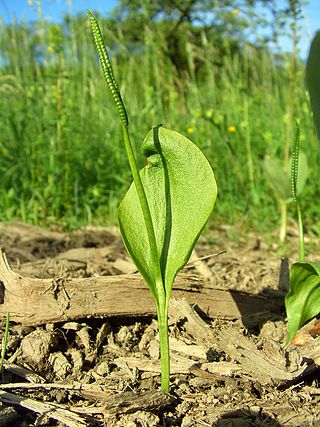
Ophioglossum vulgatum, commonly known as adder's-tongue, southern adder's-tongue or adder's-tongue fern, is a species of fern in the family Ophioglossaceae.

Equisetum fluviatile, the water horsetail or swamp horsetail, is a vascular plant that commonly grows in dense colonies along freshwater shorelines or in shallow water in ponds, swamps, ditches, and other sluggish or still waters with mud bottoms. It is a perennial herbaceous species, growing 30–100 cm tall with erect dark green stems 2–8 mm in diameter, smooth, with about 10–30 fine ridges. At each joint, the stem has a whorl of tiny, black-tipped scale leaves 5–10 mm long. Many, but not all, stems also have whorls of short ascending and spreading branches 1–5 cm long, with the longest branches on the lower middle of the stem. The side branches are slender, dark green, and have 1–8 nodes with a whorl of five scale leaves at each node. The water horsetail has the largest central hollow of the horsetails, with 80% of the stem diameter typically being hollow.

Dicksonia antarctica, the soft tree fern or man fern, is a species of evergreen tree fern native to eastern Australia, ranging from south-east Queensland, coastal New South Wales and Victoria to Tasmania.
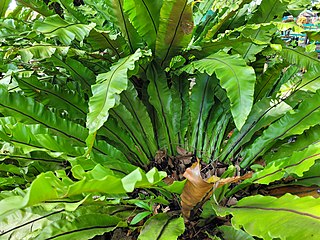
Asplenium nidus is an epiphytic species of fern in the family Aspleniaceae, native to tropical southeastern Asia, eastern Australia, Hawaii, Polynesia, Christmas Island, India, and eastern Africa. It is known by the common names bird's-nest fern or simply nest fern.

Onoclea sensibilis, the sensitive fern, also known as the bead fern, is a coarse-textured, medium to large-sized deciduous perennial fern. The name comes from its sensitivity to frost, the fronds dying quickly when first touched by it. It is sometimes treated as the only species in Onoclea, but some authors do not consider the genus monotypic.
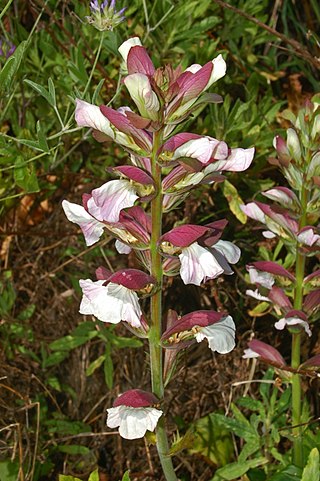
Acanthus mollis, commonly known as bear's breeches, sea dock, bear's foot plant, sea holly, gator plant or oyster plant, is a species of plant in the family Acanthaceae and is native to the Mediterranean region. It is a leafy, clump-forming perennial herb, with a rosette of relatively large, lobed or toothed leaves, and purplish and white flowers on an erect spike.

Adiantum aleuticum, the western maidenhair fern or Aleutian maidenhair, is a species of deciduous fern in the genus Adiantum.
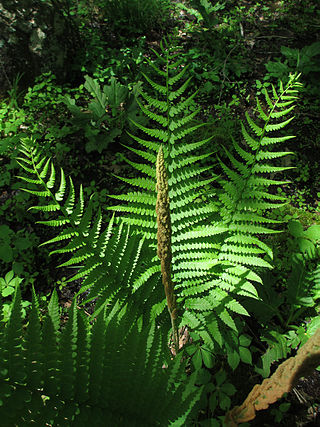
Osmundastrum is genus of leptosporangiate ferns in the family Osmundaceae with one living species, Osmundastrum cinnamomeum, the cinnamon fern. It is native to the Americas and eastern Asia, growing in swamps, bogs and moist woodlands.

Olearia argophylla, commonly known as musk daisy-bush, native musk or silver shrub, is a species of flowering plant in the family Asteraceae and is endemic to south-eastern Australia. It is a shrub or tree with silvery branchlets, egg-shaped to elliptic leaves, and white and yellow, daisy-like inflorescences.

Cyrtomium falcatum is a species of fern, commonly known as house holly-fern and Japanese holly fern, in the wood fern family Dryopteridaceae. It is native to eastern Asia.

Equisetum hyemale is a perennial herbaceous fern in the horsetail family Equisetaceae. It is a native plant throughout the Holarctic Kingdom, found in North America, Europe, and northern Asia.

Asplenium trichomanes, the maidenhair spleenwort, is a small fern in the spleenwort genus Asplenium. It is a widespread and common species, occurring almost worldwide in a variety of rocky habitats. It is a variable fern with several subspecies.

Ionactis linariifolia also known as the flax-leaf ankle-aster, flaxleaf whitetop or simply aster is a North American species of plants in the family Asteraceae.

Adiantum pedatum, the northern maidenhair fern or five-fingered fern, is a species of fern in the family Pteridaceae, native to moist forests in eastern North America. Like other ferns in the genus, the name maidenhair refers to the slender, shining black stipes.
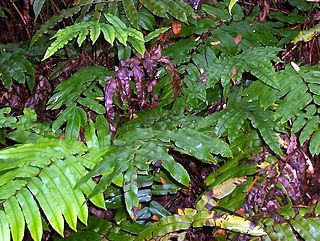
Parablechnum wattsii, synonym Blechnum wattsii, is a common terrestrial fern growing in rainforest and open forest. It is often seen near creeks in much of south eastern Australia, including Victoria, Tasmania, South Australia, New South Wales and Queensland. The specific epithet wattsii honours William Walter Watts (1856-1920). Watts was considered an authority on mosses and ferns and has more than 30 species named for him. Common names by which the species may be called are hard water fern - from its stiff leathery fronds, leech fern - as forest workers often encounter leaches while working in clusters of these ferns, hard hill fern - from the fern's habit and habitat, and red cabbage fern - from the bronze-pink colour of the young fronds resembling cooked red cabbage.
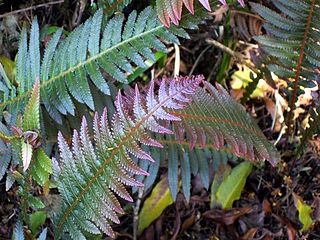
Doodia aspera, commonly known as prickly rasp fern, is a widespread and common plant, growing in eastern Australia. Often seen in rainforest margins or eucalyptus forest in Victoria, New South Wales and Queensland, it is a terrestrial fern with reddish new growth.

Polystichum proliferum, commonly known as mother shield fern is an Australian endemic fern. The genus name Polystichum is derived from Greek poly - many, and stichos - rows referring to the many rows of sori. The species name is derived from Latin, Proli – offspring and fer - bearing referring to the proliferous buds, a prominent feature of the species.
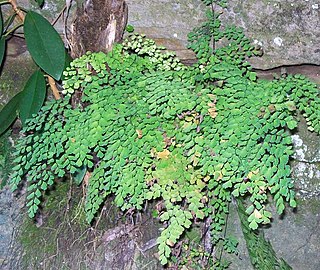
Adiantum aethiopicum, also known as the common maidenhair fern, is a small fern of widespread distribution, occurring in Africa, Australia, Norfolk Island and New Zealand.

Nephrolepis cordifolia, is a fern native to the global tropics, including northeastern Australia and Asia. It has many common names including fishbone fern, tuberous sword fern, tuber ladder fern, erect sword fern, narrow sword fern and ladder fern, and herringbone fern. It is similar to the related fern Nephrolepis exaltata.

Hymenophyllum rarum, the narrow filmy-fern, is a species of fern from the family Hymenophyllaceae. This thin-leaved fern is commonly found in New Zealand and Tasmania, growing in patches on rocks and is epiphytic on trees and tree ferns, growing in moist gullies or rainforests. A rather drought tolerant species often found at exposed sites ranging from coastal to montane areas. Forming extensive, interwoven and creeping patches with its thin long (creeping) rhizomes sparsely covered in red-brown hairs, easily recognised by its membranous grey-green fronds, the smooth margins of the pinnae, ultimate segments and indusia; and by the sunken sori in the uppermost segments of the uppermost pinnae. The species can be found throughout Tasmanian rainforests as well as occurring in New South Wales, Victoria and New Zealand on the North and South Islands as well as, Stewart, Chatham and Auckland Islands.























